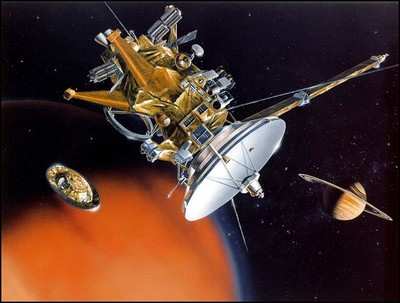Thu, Jun 04, 2009
The forecast for Titan's early autumn -- warm and wetter.
Cloud chasers studying Saturn's moon Titan say its clouds form
and move much like those on Earth, but in a much slower, more
lingering fashion.

Scientists with NASA's Cassini mission monitored Titan's atmosphere
for three-and-a-half years, between July 2004 and December 2007,
and observed more than 200 clouds. They found that the way these
clouds are distributed around Titan matches scientists' global
circulation models. The only exception is timing -- clouds are
still noticeable in the southern hemisphere while fall is
approaching.
"Titan's clouds don't move with the seasons exactly as we
expected," said Sebastien Rodriguez of the University of Paris
Diderot, in collaboration with Cassini visual and infrared mapping
spectrometer team members at the University of Nantes, France. "We
see lots of clouds during the summer in the southern hemisphere,
and this summer weather seems to last into the early fall. It looks
like Indian summer on Earth, even if the mechanisms are radically
different on Titan from those on Earth. Titan may then experience a
warmer and wetter early autumn than forecasted by the models."

On Earth, abnormally warm, dry weather periods in late autumn
occur when low-pressure systems are blocked in the winter
hemisphere. By contrast, scientists think the sluggishness of
temperature changes at the surface and low atmosphere on Titan may
be responsible for its unexpected warm and wet, hence cloudy, late
summer.
Seasons on Titan last more than seven Earth years. As Titans'
summer changes to fall at the equinox in August of this year,
Titan's clouds are expected to disappear altogether. But,
circulation models of Titan's weather and climate predict that
clouds at the southern latitudes don't wait for the equinox and
should have already faded out since 2005. However, Cassini was
still able to see clouds at these places late in 2007, and some of
them are particularly active at mid-latitudes and the equator.

Titan is the only moon in our solar system with a substantial
atmosphere, and its climate shares Earth-like characteristics.
Titan's dense, nitrogen-methane atmosphere responds much more
slowly than Earth's atmosphere, as it receives about 100 times less
sunlight because it is 10 times farther from the sun.
More News
The Industry Continues to be Rocked By Some Questionable Operations Recent investigations and a great deal of data has resulted in ANN’s SportPlane Resource Guide’s rep>[...]
Make Sure You NEVER Miss A New Story From Aero-News Network Do you ever feel like you never see posts from a certain person or page on Facebook or Instagram? Here’s how you c>[...]
Visual Approach Slope Indicator (VASI) An airport lighting facility providing vertical visual approach slope guidance to aircraft during approach to landing by radiating a directio>[...]
Airport Marking Aids Markings used on runway and taxiway surfaces to identify a specific runway, a runway threshold, a centerline, a hold line, etc. A runway should be marked in ac>[...]
Aero Linx: The Skyhawk Association The Skyhawk Association is a non-profit organization founded by former Skyhawk Pilots which is open to anyone with an affinity for the A-4 Skyhaw>[...]
 Unfortunate... ANN/SportPlane Resource Guide Adds To Cautionary Advisories
Unfortunate... ANN/SportPlane Resource Guide Adds To Cautionary Advisories ANN FAQ: Turn On Post Notifications
ANN FAQ: Turn On Post Notifications ANN's Daily Aero-Term (04.29.24): Visual Approach Slope Indicator (VASI)
ANN's Daily Aero-Term (04.29.24): Visual Approach Slope Indicator (VASI) ANN's Daily Aero-Term (04.28.24): Airport Marking Aids
ANN's Daily Aero-Term (04.28.24): Airport Marking Aids ANN's Daily Aero-Linx (04.28.24)
ANN's Daily Aero-Linx (04.28.24)





